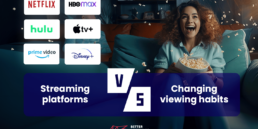While traditional TV is slowly losing its hold of the market, more and more viewers are turning to VOD for their watching habits. We present you the top trends that may shape the future of video on demand in 2019 and beyond.
Interactive Video Productions
Netflix’s recently dropped title Black Mirror: Bandersnatch is the platform’s first venture into the interactive video territory, and may soon evolve into a genre upon itself, enabling novel ways of film directing and storytelling.
The idea behind interactive video is simple: to put viewers into the driver’s seat and have them make decisions which help unravel the story. Of course, the amount of so-called choice points for such narratives is limited (e.g. more than a dozen in an hour-long film would be excessive), and the narrative system has to be well thought out so the viewers don’t break the experience by “wrong” decisions.
There are still some technological hurdles to overcome before interactive storytelling can get fully adopted by VOD audiences. For once, while Bandersnatch’s decision-making system works on certain smart TVs, internet browsers, game consoles it’s still not supported on Apple TV, some Chromecast models and other legacy devices. But the potential is real and we’ll certainly be seeing more productions like this in the coming years.
Streaming Media on the Rise
Traditional TV is not only technologically outdated compared to VOD, but it is less adapted to modern lifestyle and media consumption habits of the younger generations of viewers. This is why it’s consistently losing to VOD – which enables people to watch content on the go, stop anytime, and gives people bigger control over how, where and when they can consume media.
Due to the ongoing exodus of traditional TV subscribers, new terms have been coined to describe the status of subscribers.
- Nevers are people who have never considered TV an important medium. They never signed up for subscription television or paid for premium channels. They may, however, access media through streaming services like Netflix, Hulu, Amazon Prime, or HBO Now.
- Cord shavers are people who regularly pay for subscription television but have, for various reasons, decided to cut down on their plans. They’ve kept some of their channels, but are increasingly switching to streaming services.
-
Cord cutters are those who have completely cancelled their subscription plans and may have switched to streaming services.
 While Netflix’s US subscriber base is reaching a plateau, it’s still growing internationally at an astounding pace. Source: Netflix.
While Netflix’s US subscriber base is reaching a plateau, it’s still growing internationally at an astounding pace. Source: Netflix.
Quality of content
VOD’s allure is not limited to high image quality, with 4k and HDR (unattainable for traditional TV broadcasts). What’s more significant is that the quality of the productions themselves easily match those on the big screen, if not start to surpass them. Netflix has now either won or was nominated to a number o awards, including the Oscars, Emmy Awards, Grammy Awards and Golden Globe Awards. For example, Icarus, Netflix’s 2018 documentary by Bryan Fogel was awarded an Academy Award, as was its The White Helmets documentary in 2017.
Netflix is just one of the media providers (next to Hulu and Amazon Prime), but shows that the whole VOD industry is the force to be reckoned with. The trend is evidenced by numbers. Netflix’s user base and profits are growing at a stunning pace. In the first quarter of 2018, the stocks rose by 70%, reaching at some point $351.09 per share (it currently stands at $339.10).
WebVR
Web VR is a popular, experimental JavaScript application programming interface (API) that provides unified support for various VR goggles, including HTC Vive, Oculus Rift, Google Cardboard or OSVR – directly from the level of a web browser.
With its popularity on the rise, Web VR will be making it easier for the developers to create, and for audiences to enjoy VR experiences and share them with others. Once filmmakers adopt the new tools for the new age of storytelling, we may soon see more productions, much like those seen on the Within platform – beautiful, VR short stories.
The most important thing about WebVR is that it doesn’t require additional software to provide VR experiences. Depending on the device and browser used, everyone can experience the VR content through a VR headset, even an entry-level Google Cardboard (which will set you back just about 5USD).
Watch the video below for a sample of what is possible with WebVR.
Once the tools like WebVR become more accessible, filmmakers can explore their full potential for new, exciting productions. And VOD is the only platform to enable it technology-wise.
Even now the owners of VR helmets can get a glimpse of the VR experience by installing the Netflix VR app from the app store, and enjoying the comfort of beautiful, computer generated, cosy interior, and a gigantic screen.
VOD as a part of bigger experience
While what most people understand as VOD is not much different from traditional TV programming, but with the benefit of choosing the content, there’s much more to it – and the coming years will prove it.
VOD is poised to become a comprehensive experience, where interactive storytelling and VR mesh with each other creating immersive experiences and unforgettable narratives. Just sit and watch.
If you find this article valuable, you can share it on social media →
Read more about the VOD & OTT Industry!
March 7, 2024
7 reasons why is sports streaming becoming so popular
Learn more about the reasons why sports streaming is becoming more and more popular right now.
February 29, 2024
Why should streaming platforms adapt to changing viewing habits?
Discover the strategies through which streaming platforms adjust to changing viewing habits.
February 20, 2024
What is Titan OS and what do we know about it so far?
Explore what distinguishes Titan OS, a new smart TV operating system. Discover its unique features before giving it a try yourself.
Are you looking for a partner to build a Video Solution?
Leave your email and a short description about your project. We would gladly discuss different cooperation possibilities!






